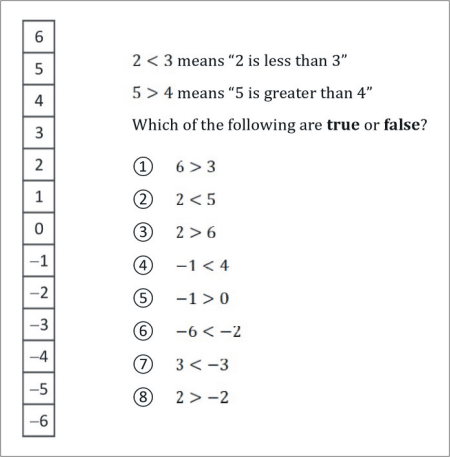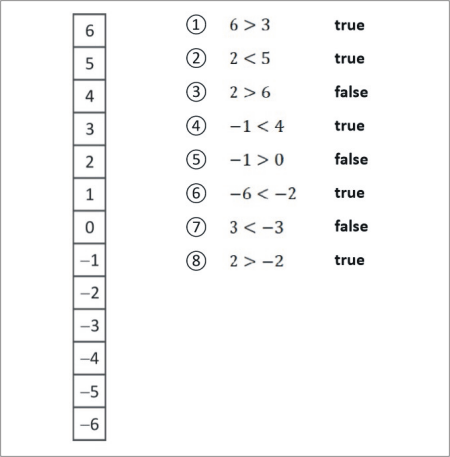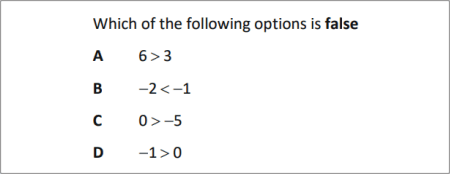|
Order and type of numbers |
|
|
|
To use the resources of this chapter you must first register |
|
|
CONTENTS |
|
|
ITEM |
|
TYPE |
|
NUMBER |
|
| Numbers by order and type |
|
Workout |
|
47 slides |
|
| Order and type of numbers |
|
Library |
|
17 questions |
|
|
|
Once you have registered, you can work through the slides one by one.
The workout comprises a series of sides that guide you systematically through the topic concept by concept, skill by skill. The slides may be used with or without the support of a tutor. The methodology is based on problem-solving that advances in logical succession by concept and difficulty. The student is presented with a problem or series of questions, and the next slide presents the fully-worked solution. To use the material you must sign-in or create an account.
blacksacademy.net comprises a complete course in mathematics with resources that are comprehensive.
|
|
|
|
SAMPLE FROM THE WORKOUT |
| Showing American English version |
SLIDE 1 - QUESTION 1 |
 |
|
SLIDE 2 - SOLUTION |
 |
|
|
SAMPLE FROM THE LIBRARY |
| Showing American English version |
QUESTION [difficulty 0.1] |
 |
|
SOLUTION |
 |
|
|
DEPENDENCIES |
|
|
|
|
CONCEPTS |
|
|
|
|
LEV. |
|
|
Greater than >, less than <
|
|
428.1 |
|
|
Greater than or equal, less than or equal
|
|
428.5 |
|
|
Greater than or equal, less than or equal is equal
|
|
428.9 |
|
|
Counting number (natural number implicit)
|
|
429.1 |
|
|
Zero as a counting number
|
|
429.2 |
|
|
Integer values in an interval
|
|
429.3 |
|
|
Integer
|
|
429.5 |
|
|
Ordinal (implicit)
|
|
429.7 |
|
|
Ascending, descending order
|
|
429.9 |
|
|
< as order relation (implicit)
|
|
430.1 |
|
|
Fraction as class larger than integers
|
|
430.5 |
|
|
Long division past the decimal point
|
|
430.9 |
|
|
Recurring decimals
|
|
431.3 |
|
|
Exact and inexact (approximation)
|
|
431.9 |
|
|
Rounding up
|
|
432.2 |
|
|
Estimation
|
|
432.6 |
|
|
|
|
RAW CONTENT OF THE WORKOUT |
|
| To make use of this chapter, please first register. Then you can work through the slides one by one. |
|
| What is provided here is the raw text of the workout. Most of the information is contained in the image files, which are not included with this text. The text may appear deceptively short. (The content overall of blacksacademy.net is vast.) Any in-line questions appear as a question mark [?]. This text is provided only as an indication of the overall quantity of material contained in the chapter. To use the material you must sign-in or create an account. |
|
| * |
|
|
SLIDE 1
means “2 is less than 3”
means “5 is greater than 4”
Which of the following are true or false?
?
?
?
?
?
?
?
?
SLIDE 2
?
?
?
?
?
?
?
?
true
true
false
true
false
true
false
true
SLIDE 3
Add < or > to make a true statement
? ?
? ?
? ?
? ?
SLIDE 4
? ?
? ?
? ?
? ?
SLIDE 5
means “less than or equal”
means “greater than or equal”
Which of the following are ?
45 78 60 49
99 38 27
14 63 90 11
SLIDE 6
45 78 60 49
99 38 27
14 63 90 11
SLIDE 7
Which of the following are ?
77 43 65 75
108 71 97
34 100 999 2
SLIDE 8
77 43 65 75
108 71 97
34 100 999 2
SLIDE 8
I am thinking of a number
My number is
My number is
What is my number?
SLIDE 9
I am thinking of a number. My number is . My number is . What is my number?
My number is 9
SLIDE 11
The counting numbers are whole numbers starting with 0.
A counting number is a number that answer a question such as, “How many sheep are in the field?”
FYI. During the Roman period, the Romans did not recognise zero as a counting number.
Question
Which of the following are counting numbers?
? ?
? ?
? ?
SLIDE 12
The counting numbers are whole numbers starting with 0.
Which of the following are counting numbers?
? Yes. It is a counting number.
? Yes. It is a counting number.
? No. There cannot be a minus number of sheep.
? No. Half a sheep is not a living sheep in a field.
? No. A negative half sheep is not a sheep.
? It depends!
Whether to count zero as a counting number or not is a question of what rule you wish to adopt. Some people call zero a counting number, and some do not.
Here we regard zero as a counting number.
SLIDE 12
? I have some counting numbers such that
What are my numbers?
? I have some counting numbers such that and .
What are my numbers?
SLIDE 13
? I have some counting numbers such that
My numbers are 5, 6, 7, 8, 9 and 10.
? I have some counting numbers such that and .
My numbers are 9, 10, 11, 12, 13, 14 and 15.
SLIDE 14
The integers are positive and negative whole numbers.
Integers answer questions like, “How many steps do I need to take left or right to reach my destination?” or, “How many degrees above or below 0 is the temperature today?” Answers to questions of this kind can be positive or negative whole numbers.
Which of the following are integers?
? ?
? ?
? ?
SLIDE 15
The integers are positive and negative whole numbers.
Which of the following are integers?
? Yes. It is a positive whole number.
? Yes. It is a positive whole number
? Yes. It is a negative whole number.
? No. It is not a whole number.
? No. It is not a whole number.
? Yes. It must be an integer because it is between the positive and the negative whole numbers.
SLIDE 16
In a race these were the times in seconds of six contestants.
Sam 16.5
Sally 17.1
Sophie 14.3
Stephen 18.0
Simon 15.9
Sian 13.8
Put these times in order from fastest to slowest and find out who came first, second, third, etc.
SLIDE 17
1st Sian 13.8
2nd Sophie 14.3
3rd Simon 15.9
4th Sam 16.5
5th Sally 17.1
6th Stephen 18.0
SLIDE 19
This is a list of the 12 longest rivers and their lengths in miles.
Put them in descending order from longest to shortest.
Mississippi 3902
Congo 2922
Mekong 2705
Ob-Irtysh 3364
Yellow 3335
Mackenzie 2637
Nile 4130
Amazon 4086
Rio de la Plata 3030
Yangtze 3917
Amur 2763
Yenisei 3445
SLIDE 20
1 Nile 4130
2 Amazon 4086
3 Yangtze 3917
4 Mississippi 3902
5 Yenisei 3445
6 Yellow 3335
7 Ob-Irtysh 3364
8 Rio de la Plata 3030
9 Congo 2922
10 Amur 2763
11 Mekong 2705
12 Mackenzie 2637
SLIDE 21
Do the same with
?
?
SLIDE 22
?
?
SLIDE 23
Do the same with
?
?
SLIDE 24
?
?
SLIDE 25
The fractions include numbers that are neither counting numbers nor integers.
All counting numbers and integers, positive or negative, are also fractions.
This is because any number can be divided by 1.
Which of the following are fractions but not integers?
?
?
?
? 25
? 2
SLIDE 26
? fraction only, not an integer
? both a fraction and an integer
? fraction only, not an integer
? 25 both a fraction and an integer
? 2 fraction only, not an integer
SLIDE 27
Work out
? ? ?
SLIDE 28
? ? ?
SLIDE 29
Long division past the decimal point
We can continue long division beyond the decimal point
? Find by long division
? What is ?
SLIDE 30
?
?
SLIDE 31
Use long division past the decimal point to find
?
?
SLIDE 32
? ?
? ?
SLIDE 33
Recurring decimals
Use long division past the decimal point to find as a decimal.
Go only up to the third decimal place. What do you observe?
SLIDE 34
The situation where you are dividing the number 10 by 3 keeps on repeating itself.
You can never complete this process. The calculation never ends.
Because we can see this process repeating, we write
The dots show that the same digit(s) keep on repeating themselves. This is called a recurring decimal.
SLIDE 35
Use the calculator to find
? ? ?
Use dots to express these numbers as recurring decimals
SLIDE 36
?
?
?
SLIDE 37
What difference does the dots make between these?
Which one of them is true and correct? Which one is false and incorrect?
SLIDE 38
This is true and correct
This is false and incorrect
SLIDE 39
Exact
Inexact approximation
We show an approximation by .
Using makes true.
It is true that is approximately 0.333
Classify each of the following as exact or inexact.
? ?
? ? 1
? 2 ?
SLIDE 40
? inexact
? exact
? exact
? 1 exact
? 2 inexact
? exact
SLIDE 41
One of these statements is true, and the other is false. Which is which, and why?
SLIDE 42
is false is true
is not approximately 0.666. This is because 6 is closer to 10 than to 0.
When we approximate a number, we must check to see whether the last digit in the approximation needs to be rounded up.
Which of the following digits are closer to 10 than to 0?
0 1 2 3 4 5 6 7 8 9
SLIDE 43
The digits 5, 6, 7, 8 and 9 are closer to 10.
These digits must be rounded up if there is an approximation.
SLIDE 44
If needed, round up the last digit of each of the following. Make an approximation.
? ? 1
? ?
? ?
SLIDE 45
?
? 1 1
?
?
?
?
SLIDE 46
Estimate the result of multiplying 3212 by 618.
We approximate 2312 to the nearest 1000 and 618 to the nearest 100, and then we divide.
= = 5
Estimate is 5.
Make estimates for
? ?
? ?
?
SLIDE 47
?
?
?
?
?
|
|